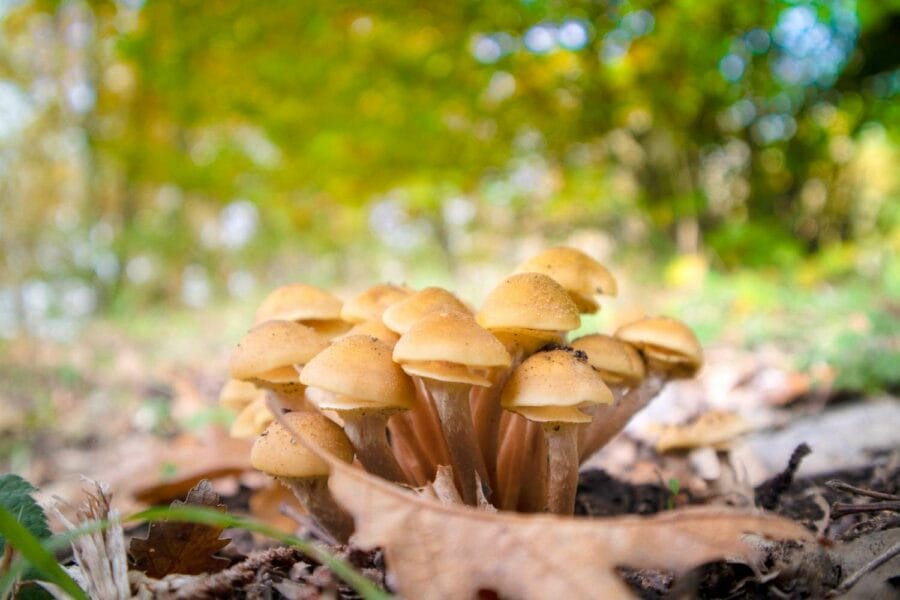Psilocybin, a psychoactive component in magic mushrooms, is popularly used recreationally for its euphoria-inducing and hallucinogenic effects.
Aside from its mind-altering capabilities, researchers have examined the potential of this compound for mitigating chronic pain.
This piece delves into a case study investigating the potential of microdosing mushrooms in managing chronic pain.
Key Takeaways:
- Microdosing mushrooms may provide both immediate and sustained relief from pain.
- When used in small doses, psilocybin microdosing tends to have fewer side effects compared to traditional pain medicine.
- Psilocybin interacts with serotonin 2A (5-HT2A) receptors, contributing to pain relief among other effects.

The Study
Dr. Matthew Lyes and his team from the Division of Pain Medicine in the Department of Anesthesiology at the University of California, San Diego, carried out a study named “Microdosing Psilocybin for Chronic Pain: A Case Series“. The study focused on three patients who were self-medicating with small doses of psilocybin to manage their chronic pain symptoms.
Three Patients, One Result – Reduction of Chronic Pain
Patient # 1
| AGE/ GENDER: | 37 Male |
| TYPE OF PAIN: | Pain below the site of a spinal cord injury, of a neuropathic nature. |
| PAIN LEVEL: | Started at 4 to 5/ 10, rising up to 8/ 10 later during the day |
| PSILOCYBIN DOSE: | 250 mg of ground mushroom for under 6 months |
| RESULT: | Discontinuation of prescribed pain medication, a decrease in muscle spasms, and improved bowel movement efficiency. No signs of rebound pain or withdrawal symptoms were noted. |
| The patient reported that while his usual medications only managed to diminish the pain, psilocybin effectively eradicated it, reducing his average pain level from 5 to 0. | |
Case Study: Subject #2
| AGE/ GENDER: | 69-year-old female |
| TYPE OF PAIN: | Complex Regional Pain Syndrome (CRPS) |
| INTENSITY OF PAIN: | Typically fluctuating between 5 and 7 out of 10, but increases with physical activity and during pain flare-ups |
| PSILOCYBIN DOSAGE: | Daily dosage of 500 mg for 7 to 10 days, followed by rest periods of 2 to 3 days over a year. Dosage escalates to 750 mg to 1 gram during pain flare-ups |
| IMPACT: | Pain reduction by 80% for 3-4 hours, slowly reverting to initial levels after 12 hours. Complete pain relief (90%-100%) lasts 6-8 hours, then returns to initial levels after 18 hours. |
| The subject reports a decrease in appetite without experiencing nausea. Disorientation or imbalance while walking is observed when the dosage is increased (750 to 1000mg). | |
Case Study: Subject # 3
| AGE/ GENDER: | 40-year-old female |
| TYPE OF PAIN: | Lumbar radiculopathy and neuropathic pain |
| INTENSITY OF PAIN: | 8 out of 10, peaking to 10 out of 10 during physical exertion |
| PSILOCYBIN DOSAGE: | 1000 mg from a mushroom chocolate bar every two months. |
| IMPACT: | Significant relief from pain without experiencing psychoactive effects. Increase in flexibility and functionality reported. Pain gradually reverts to initial levels over a period of 2-4 weeks. Repeated dosing enhances control over pain. |
| The subject does not report any discernible physical, cognitive, or behavioural side effects. Her mood remains mostly stable. She continues her standard dosage of her SSRI for depression management throughout the psilocybin treatment period. | |
Exploring Pain Management with Psilocybin
Continuous signals of somatic and visceral pain reinforce certain neural pathways due to peripheral and central sensitization, resulting in a chronic sensation of pain both physically and emotionally. Psychedelics like psilocybin stimulate 5-HT2A receptors, potentially rebooting the brain areas associated with neuropathic conditions.
One patient reported extended pain relief for several weeks. This suggests that post direct stimulation of the 5-HT2A receptors, a central regulation of pain perception and synaptic adaptability.
Potential Side Effects: Psilocybin Vs. Traditional Pain Relievers
| PSILOCYBIN (As per Studies) | TRADITIONAL PAIN RELIEVERS |
| Muscle spasms | Nausea |
| Decreased appetite | Stomach discomfort |
| Confusion | Headaches |
| Unsteady gait | Dependency |
| No mood changes | Drowsiness |
Potential Areas for Future Psilocybin Research
The research team has identified several potential research areas that should be further investigated, based on the experiences of three individuals and their potential benefits.
- Low doses of psilocybin could provide immediate and possibly long-lasting relief from neuropathic pain, without resulting in physical tolerance or addiction.
- Examine the impact of different treatment strategies combined with psilocybin. As an example, patient #3 reported an increased pain-relieving effect when psilocybin was combined with physical therapy.
- Even without psychotherapy, minor doses of psilocybin might alleviate pain, as demonstrated in this case study. The researchers suggest that therapy may enhance or prolong these therapeutic effects.
Study Limitations
Despite the encouraging results noted in the patients, it’s essential to acknowledge the limitations identified in the study.
- The limited sample size may not fully represent the broader population of individuals suffering from neuropathic pain.
- The study didn’t include any subjects who didn’t respond to psilocybin treatment.
- No assessments were conducted before and after treatment to measure the impact of psilocybin on mental health conditions like depression and anxiety.
- Most of the data was self-reported by the subjects, which may introduce bias.
- The presence of the researcher and the potential bias related to psilocybin could have influenced the participants’ responses.
- The study did not investigate the potential influence of the placebo effect.
- The study did not measure the exact amount of psilocybin present in each mushroom.
Microdosing Psilocybin Mushrooms
In the study under discussion, Patients #1 and #2 consumed a microdose of psilocybin in its powdered form, extracted from dried mushrooms. In contrast, patient #3 combined it with chocolate. There are many products available for psilocybin microdosing, and we have put together a brief list of some of them below.
Dehydrated Mushrooms
The study did not mention the specific strain used, but the one listed below can be a great starting point for newbies.
- Golden Teacher: This is one of the most commonly seen and widely used strains of psychedelic mushrooms.
- Amazonian Cubensis: This strain is known for its user-friendliness and cognitive benefits.
- Cambodian: Microdosing with Cambodian cubensis mushrooms can potentially improve concentration, social awareness, and mood.
Microdose Capsule Options
- Euphoria Psychedelics – Micro Calm Capsules: This concoction includes Ashwagandha, Reishi, CBD, Valerian root, and Psilocybin Mushrooms, which are all scientifically backed for their anxiety and stress reduction properties.
- Ground Sounds – Microdose Capsules – Champion Lover: This intriguing blend offers three dosage options of pure psilocybin: 50mg, 100mg, or 250mg, combined with reishi, cacao, cordyceps, and maca.
- Kind Stranger – Brighten Capsules 250mg: These capsules feature the Golden Teacher strain, renowned for promoting clarity, enhanced creativity, and improved focus.
Using Psilocybin to Manage Pain
While the study of mushrooms’ pain-relieving properties is still in the preliminary stages, emerging anecdotal evidence and small-scale case studies are providing promising leads.
These instances underscore the need for continued research into the potential benefits of psilocybin, class=”wp-block-list”>
The potential of psilocybin in managing chronic pain is increasingly recognized. The promising findings from case studies give hope to those enduring chronic pain.
Frequently Asked Questions
What effects does psilocybin microdosing produce?
Psilocybin mainly activates a serotonin receptor known as “5-HT2A” in the prefrontal cortex, leading to two primary outcomes:
- Generation of “Brain-Derived Neurotrophic Factor” (BDNF)
- Boosted “Glutamate” transmission
Besides, psychedelics foster links between less frequently interacting brain areas. This unique connectivity stems from psychedelics’ ability to decrease the activity of the “Default Mode Network” (DMN), which is linked to various cognitive functions, including daydreaming, introspection, and reflecting on the past and future.
What is microdosing mushrooms’ most noted benefit?
Microdosing may enhance mood, productivity, creativity, and concentration. Its most extensively researched benefit is its influence on mental health.
In November 2022, COMPASS Pathways, a mental health company, disclosed the outcomes of their thorough phase 2b trial, a randomized and double-blind study. Their findings indicated that a single dose of psilocybin resulted in substantial reductions in depressive symptoms compared to a placebo. Participants who received a higher dose of 25 milligrams showed a sustained antidepressant response at the twelve-week follow-up.
A study published in the Psychiatry Research Journal suggested that psilocybin is more effective than traditional antidepressant treatments.
How do you determine your dosage?
Start with a 0.1-gram dose of psilocybin mushrooms on the first day. If the desired effects are not achieved, you can slowly increase your dose by 0.05 grams on subsequent microdosing days until you find your ideal amount.
People with a history of psychotropic drug usage may need to elevate the dose to 0.5 grams to attain the desired effects.
What should one do before taking mushrooms?
class=”wp-block-list”>What is the suggested frequency for consuming microdoses of mushrooms?
A variety of standardized protocols recommend specific microdosing schedules for psychedelics. The primary difference between these protocols is the number of “off” days they include, which are the days you abstain from microdosing.
The most commonly recommended protocols advise incorporating 1-3 rest days between microdoses, aligning with the body’s natural tolerance mechanisms. The three protocols being discussed here are the Fadiman Protocol, the Stamets Stack, and intuitive microdosing.




